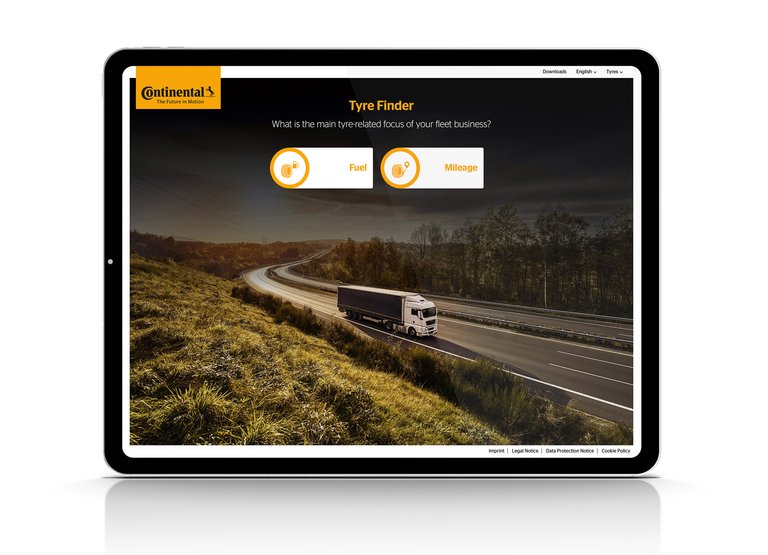VECTO: Continental Offers CO2 and Fuel Consumption Calculator to Perform Sustainability Check on Its Tires
- Continental tool makes sustainability transparent and highlights potential savings
- Calculator computes CO2 emissions for tires on steer and drive axles
- New tool rounds out VECTO microsite with technical details on rolling resistance
Hanover, Germany, May 5, 2021. The topic of VECTO and the EU Emissions Regulation currently ranks among the most pressing challenges for the haulage industry. The industry’s CO2 emissions are to undergo radical reduction by 2030, and the tire selection process is of direct relevance here. To make that process more transparent, Continental is providing detailed information on its website and has just added an innovative CO2 and fuel consumption calculator to its online offering. This new tool is designed to let fleet operators calculate exactly how much they will save in terms of emissions by choosing the right Continental tires for their specific applications. Because the interplay of the tire’s mission profile, structure and rolling resistance makes a decisive difference to how much fuel is consumed and/or can be saved.
With this tool, Continental is offering its customers a comprehensive, practice-oriented package that informs them in detail about the EU Regulation and its impact on the haulage industry. Development of the new calculator, which rounds out the existing microsite, was based on the VECTO method of calculation. On the microsite, users will discover how VECTO works and learn about the impact of rolling resistance on fuel consumption and the associated costs. The calculator delivers a clear illustration of the difference that tires can make in efforts to reduce CO2 emissions.
Focus on rolling resistance
When a vehicle is in motion, the tires are exposed to a range of different forces that cause the tires to continually deform and recover their shape. In this process, known as hysteresis, energy is lost (i.e. dissipated in the form of heat). Hysteresis is one of the main causes of rolling resistance in tires. To overcome the rolling resistance and maintain the vehicle’s forward momentum, more energy is required in form of fuel. So rolling resistance is a major factor in determining the fuel consumption of a vehicle and the associated CO2 emissions. This shows how important it is to select the right tires for the vehicle’s mission profile, because together with mileage, grip and robustness, rolling resistance is a key factor in determining the performance of a tire.
When fleet managers calculate the efficiency of their fleet, they need to be aware of rolling resistance as a cost factor. And so Continental developed its new CO2 and fuel consumption calculator, making the choice of tires a transparent process for the customer.
“With the new calculator, we’re delighted to offer our customers another means of making their operations more sustainability-focused,” says Enno Straten, responsible for Marketing Replacement Tires EMEA at Continental. “In this way we’re adding to our service expertise – and with a sales team specially trained in these matters, we can provide even more comprehensive advice.”
Fuel consumption figures by tire type and mission profile
Here’s how the calculator works: The customer starts by entering the mission profile of each vehicle. Based on telemetry data, the individual payload and application of the vehicle can also be factored in. The calculator uses this information to work out how much fuel the vehicle will consume with each specific type of tire and shows the different fuel consumption figures for each tire line dependent on the application. “The tires should be selected to match the type of work the vehicle is expected to handle,” says Straten. “We recommend different tires for long-haul work than for regional distribution duties. The choice of tire makes a decisive difference in terms of the vehicle’s fuel consumption and the associated emissions. And sustainability has become a key factor in our customers’ purchase decisions.” Complementing the Tire Finder, the new calculator now provides the customer with a clear picture of each tire’s sustainability.
Choosing the right tire with the Tire Finder
The Tire Finder platform helps fleet managers choose the right tires for their long-haul or regional distribution operations. The core requirements of the fleet are analyzed in two steps before the Tire Finder recommends a suitable tire line. In the first step, the tool distinguishes between the fuel efficiency and mileage of the tires. The second step takes their everyday mission profile into account. Do they operate mainly on motorways or regional roads? Does the truck usually handle long-distance haulage or short-haul deliveries? The Tire Finder informs the customer about the tire portfolio and the characteristics of the individual tires. The customer then decides which type of tire makes the best fit for their business.
Backstory: VECTO and cutting CO2 emissions
According to EU data, 25 percent of CO2 emissions from road transport across Europe are generated by heavy-duty vehicles. Along with tire pressures, vehicle configuration and load distribution, the rolling resistance of the tires plays a decisive role in determining fuel consumption and thus CO2 emissions. The European Regulation setting out CO2 emission standards for new heavy-duty vehicles came into force in 2019. It specifies that vehicle manufacturers must cut the CO2 emissions of vehicles covered by the Regulation by 15 percent by 2025 and by 30 percent by 2030, in both cases using July 2019 to June 2020 as the reference year.

Annette Rojas
Business Area Replacement Tires EMEA
Spokesperson Commercial Vehicle Tires
Continental Tires


